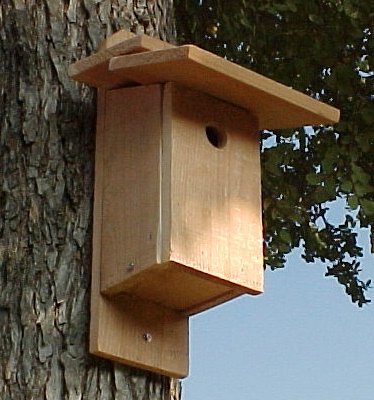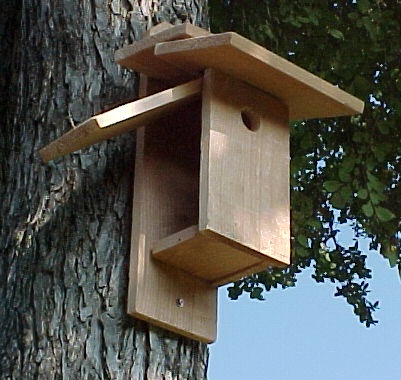
[Title] [text TOC] [image TOC] [Site Search]
 [Donation]
[Donation]

 [Donation]
[Donation]
 |
Birdhouse |  |
|---|


| Materials | Tools |
|---|---|
|
6'x1"x6" wood 24 nails 2" 1 screw 2" 1 screw 3" |
Pencil Square Tape measure Drill and bits 1 1/4" bit Saw Clamp and saw horse Sandpaper Hammer Screwdriver Caulk |
For other activities, see the Activities Chapter.
Attracting birds to your yard can be very entertaining. It's fun to watch them feeding, bathing, building nests, socializing, and taking care of their young. You will have the most success attracting birds if you provide for all of their needs.
Food - Natural foods such as berries, seeds, and insects are very important. Add plants to your landscape that are a good source of food like sunflowers, firethorn, cotoneaster, staghorn sumac, mountain ash, winterberry holly, and eastern red cedar. You can also supplement natural foods with black oil sunflower seeds, suet feeders, and peanuts (whole in shells, shelled, and parts). Limiting your use of pesticides will not only increase the amount of food available, but the birds won't be eating the poisoned insects.
For some extra excitement, add some plants to your landscape that attract hummingbirds. Almost any red, orange, or pink tubular flowers will do. Some of the best are: trumpet creeper hybrid, Turks cap, and red salvia. You might also add a feeder filled with four parts water and one part table sugar. Bring the water to a boil and mix in the sugar. Store it in the refrigerator. Change the sugar water in your feeder every three days as it will spoil.
While you are at it why not add some plants for butterflies: butterfly bush, milkweed, or butterfly weed.
Water - Birds need water for drinking and bathing to keep their feathers clean. This could be a natural source like a stream or pond, a constructed pond or birdbath, or a purchased birdbath. The water needs to be 1-2" deep. A sloping bottom is best because it allows the birds to go in as deep as they wish.
Shelter - Birds feel more secure when they have easy access to shrubs and trees. Evergreen shrubs and trees are especially attractive to them because they provide year round protection from enemies and weather. Some of the best are: juniper, eastern red cedar, hollies, and hemlock. Old, dead limbs and trees are great for attracting woodpeckers and many other species.
Place to raise their young - Some birds build their nests in tree branches or on platforms, some on the ground, and others in cavities or holes in trees or bird houses.
It is important to know what types of birds will be attracted to your yard. This will depend a great deal on where you live and what types of habitat you provide and what habitats surround you. Some of the more common birds in the continental United States that might be attracted to move into a birdhouse include wren, finch, chickadee, titmouse, and nuthatch.
You will find that most of these birds (and many animals for that matter) at the transition between forest and grassland. The trees provide cover and shelter and the grasslands provide seeds and insects.
Check with local nurseries especially those dealing with native plants, museums, nature centers, and the Audubon Society for more information. Libraries also have many great books on birds and the Internet is a great resource.
Of course, it's very rewarding to build a house and have a family of birds move into it. Cavity nesters are the easiest to attract. Different sizes of birds require different size houses. Below is a table that lists the sizes appropriate for different birds.
| Species | Floor | Depth | Height of Entrance | Diameter of Entrance | Height from Ground |
|---|---|---|---|---|---|
| Bluebird | 5x5" | 8" | 6" | 1 1/2" | 5-10' |
| Chickadee | 4x4" | 9" | 7" | 1 1/8" | 6-15' |
| Titmouse | 4x4" | 9" | 7" | 1 1/4" | 6-15' |
| Carolina Wren | 4x4" | 8" | 6" | 1 1/4" | 6-10' |
| Purple Martin | 7x7" | 6" | 1" | 2 1/2" | 10-20' |
| Crested Flycatcher | 6x6" | 10" | 7" | 2" | 8-20' |
| Red-bellied Woodpecker | 6x6" | 14" | 11" | 2" | 10-20' |
| Downy Woodpecker | 4x4" | 9" | 7" | 1 1/4" | 6-20' |
| Kestrel | 8x8" | 15" | 11" | 3" | 10-20' |
| Barn Owl | 10x10" | 18" | 8" | 6" | 12-20' |
| Screech Owl | 8x8" | 15" | 11" | 3" | 10-20' |
The diameter of the entrance hole is very important. If it is too small the bird can't get inside. If it is too large unwanted birds may take it over. This is especially true of the more aggressive non-native species.
This design has many features that will help you and the birds be successful.
The birdhouse featured here is for downy woodpeckers. Adjust the sizes and measurements as appropriate for other size birds. A few extra nails and screws will be needed for larger houses. You may want to change the sizes slightly to best fit the size of lumber that is available to you.


The best time to put up your birdhouse is in the fall. Some birds will explore and roost in them during the winter. Place your birdhouse so that you can easily watch it from indoors so that you can enjoy all the action. Hang it so the entrance faces away from prevailing winds - generally the entrance should be facing the east. It should be at least five feet above the ground. It may take a year or two for birds to move in. If they don't after two years, change its location.
Don't forget to clean out your birdhouse every year in February.